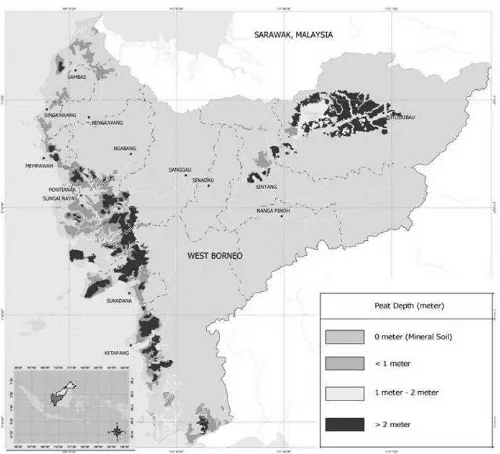Simulating Bioethanol Production from Sago Palm Grown on Peatland
of West Kalimantan, Indonesia
Evi Gusmayanti, Maherawati, Ari Krisnohadi, Sholahuddin Faculty of Agriculture
University of Tanjungpura Pontianak, Indonesia vie_tep02@yahoo.com
Abstract— Bioethanol is one of renewable energy which is becoming a hot issue as energy crisis crushed almost all countries world wide. It is produced from starchy cellulose-rich plants such as rice, corn, cassava, sugarcane, sorghum, and sago palm. In Indonesia, sago palm is a potential candidate to be used as a raw material for bioethanol production. Beside its benefits such as high starch productivity, relatively sustainable, environmental friendly and multitude of usages, sago starch is not widely consumed as staple food. Therefore using this starch may not adversly affect food security. In West Kalimantan, peatland is a potential area for growing sago palm. It can thrive and nourish on these swampy areas without high external input as do for many other crops. Given the data of sago starch production, we simulate the production of bioethanol by using conversion factor from starch into bioethanol. Applying scenario of growing sago palm along river bank ( up to 200 m, 400m, 600m, 800m, and 1000m from the river bank), bioethanol production were mapped.
Keywords-bioethanol, peatland, sago palm, west kalimantan
I. INTRODUCTION
The high price of fossil fuel due to oil depletion leads a lot effort to find alternative energy sources. Bioethanol is one of the alternative energy sources that is believed to be sustainable and environmentally friendly. It is produced from starchy cellulose rich plant, such as rice, corn, cassava, sugarcane, sorghum, and sago palm.
In Indonesia, sago palm seems to be a potential feedstock for bioethanol. Its productivity can reach up to 25 tonnes of dried starch per hectar per year [1]. It is much higher compared to other starchy crops such as rice and corn which is about 6 tonnes/ha and 5.5 tonnes/ha respectively [2]. Sago palm is relatively sustainable, once cultivated it is not necessary for re-planting since it is propagated majorly by suckers. It is also environmental friendly, it can grow well with no or minimal external input and management practices lead to low negative impact to its environment. Moreover, sago starch currently is not widely consumed as staple food [3]. Therefore the moral issue againts food security can be minimalized.
Given the fact that sago palm can thrive and nourish on swampy and acidic peat soils which are unsuitable for other crops, it can be a promising commodity in West Kalimantan where 1.9 million hectares of peat soils are found. Currently peat land in this province is reclaimed for agricultural practices with low until high external input to be optimally productive. Reclamation of this peat land seems permissible due to economic pressure for food and energy supply. However the environmental issue comes into concern in recent years. Exploitation of peat land is believed to be a significant source of carbon lead to the increasing of greenhouse gas emission. In line with the issue sago palm is a promising crop, since it can grow naturally without draining the peat and no application of fertilizer [4]. Indeed, to ensure optimal production, improvement of soil quality is necessary.
The paper is addressed to describe the opportunity of sago palm as bioethanol feedstock. By applying scenarios of growing sago palm along river bank at different distances from the river, potential sago starch and the potential bioethanol produced from it were mapped.
Figure 1. Map of West Kalimantan and distribution of peatland over the area
TABLE I. COVERAGE OF PEATLAND IN WEST KALIMANTAN
Peat Depth Area (hectare) Percentage (%)
Shallow (<1m) 877,538 5.96
Moderate (1 – 2 m) 233,472 1.59
Deep (>2 m) 863,396 5.86
Peat Area 1,974,406 13.41
Figure 4. Potential production of bioethanol along river bank in West Kalimantan at various distances, i.e. a) 0-200 m, b) 0-600 m, c) 0-1000 m, and d) all distances from river
IV. CONCLUSION
Sago palm is a prospective feedstock of bioethanol that can be grown on peatland of West Kalimantan, Indonesia. Based on common practice in the region, sago palm can produce starch at least 10 tonnes of dried starch per hectare on shallow and moderate peat. It is potentially equal to 6 kilolitres of bioethanol. With assumption of sago palm cultivation on 75% of suitable peatland area, West Kalimantan will have bioethanol surplus according to government policy to use gasohol 10% by year 2015.
REFERENCES
[1] Sumaryono. “Tanaman Sagu sebagai Sumber Energi Alternatif”. Warta Penelitian dan Pengembangan Pertanian. Vo 29 No. 4, 2007.
[2] Badan Pengkajian dan Penerapan Teknologi. Sagu, Potensial Perkaya
Keragaman Pangan. 2006. http://www.bppt.go.id/index.php? option=com_content&task=view&id=6033&Itemid=30 browsed 19
July 2007
[3] D. A. Mampioper, “Sagu sumber karbohidrat yang terlupakan”, Berita Bumi, 30 Nov 2006. http://www.beritabumi.or.id/ artikel3.php?idartikel=269 Browsed July 19, 2007.
